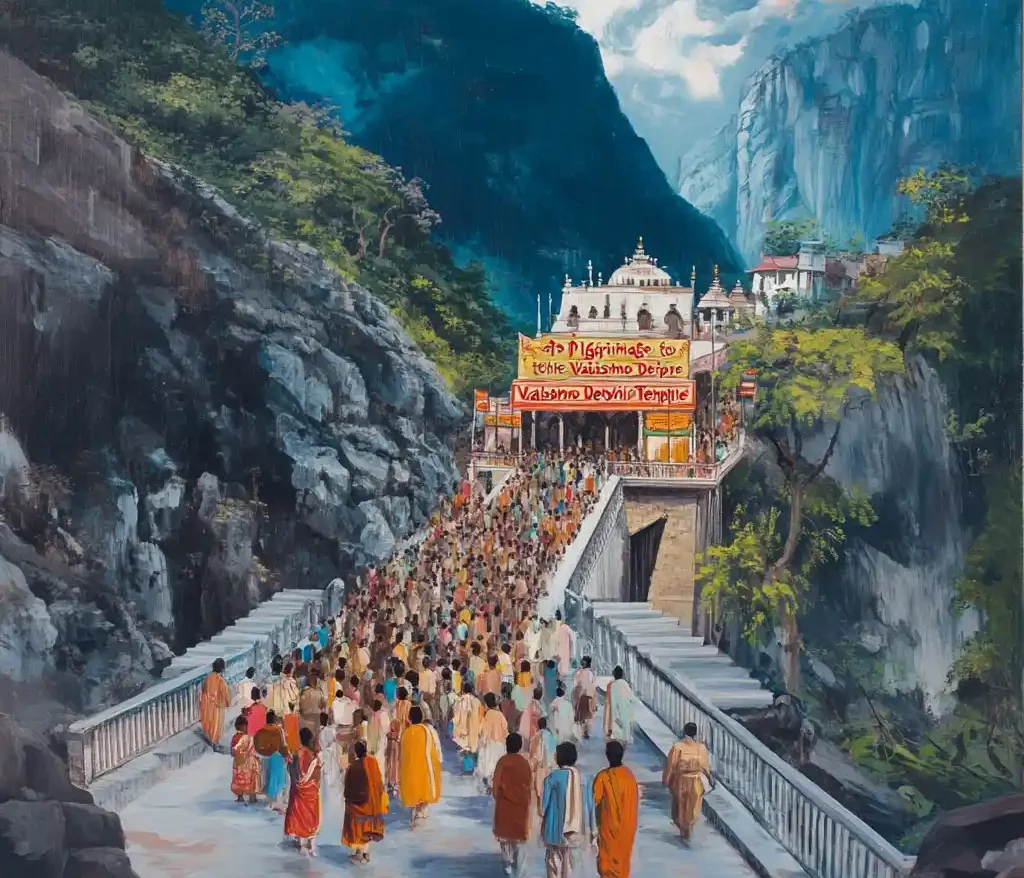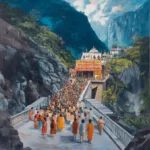The Spiritual Significance of Vaishno Devi
According to Hindu beliefs, Vaishno Devi manifests as a combination of Mahalakshmi, Mahasaraswati, and Mahakali. She represents strength, wisdom, and prosperity, guiding her devotees toward enlightenment.
Unlike many temples that house idols, Vaishno Devi stands apart. Inside the sacred cave, three naturally formed rock formations, known as Pindis, symbolize her divine presence. These sacred stones radiate powerful energy, blessing all who visit.
For many, the journey to Vaishno Devi mirrors life’s challenges. The steep climb, physical endurance, and unwavering faith reflect human struggles and perseverance. As pilgrims ascend, they chant “Jai Mata Di!”, creating an atmosphere filled with devotion and unity.
Legends and Mythological Significance
The origins of Vaishno Devi remain deeply rooted in Hindu mythology. According to legends, the goddess was born as Vaishnavi, an ardent devotee of Lord Vishnu. She dedicated herself to meditation and asceticism, seeking spiritual enlightenment.
The Legend of Bhairon Nath
As her fame spread, a powerful demon, Bhairon Nath, became obsessed with her. He pursued her relentlessly, convinced that she was no ordinary woman. To escape him, Vaishnavi fled to the Trikuta Mountains, where she meditated inside a cave.
When Bhairon Nath finally confronted her, she revealed her divine form and beheaded him. However, before dying, he realized his mistake and repented. Out of compassion, the goddess forgave him and declared that every devotee must visit his temple after seeking her blessings.
Even today, pilgrims complete their journey by visiting Bhairon Nath Temple, located 2.5 km above the main shrine. Without this final step, their pilgrimage remains incomplete.
Other Legends and Divine Connections
- Lord Rama’s Blessing: Some scriptures state that Vaishno Devi performed penance to marry Lord Rama. However, he instructed her to meditate until Kali Yuga, promising to acknowledge her devotion in the future.
- Pandavas’ Worship: The Mahabharata suggests that the Pandavas visited and worshiped at Vaishno Devi, further cementing its sanctity.
- Guru Gobind Singh’s Visit: The tenth Sikh Guru, Guru Gobind Singh, reportedly undertook this pilgrimage, reinforcing its significance across faiths.
The Trek to Vaishno Devi: A Test of Devotion
The pilgrimage to Vaishno Devi begins at Katra, a bustling town 50 km from Jammu. From here, devotees embark on a 13-km trek through rugged mountains, breathtaking landscapes, and spiritually uplifting surroundings.
Pilgrimage Routes
Devotees can choose from three main routes to reach the shrine:
Traditional Route (13 km)
- The oldest and most frequently used path
- Features rest stops, refreshment stalls, and small shrines
- Pilgrims chant “Jai Mata Di” as they climb steep inclines
Himkoti Route (12 km, Alternative Path)
- A scenic yet steeper option
- Less crowded, making it ideal for experienced trekkers
Tarakote Marg (7.5 km, New Route)
- Easier and well-lit with medical facilities
- Suitable for families and elderly pilgrims
Modes of Travel
- Walking: Most devotees prefer completing the journey on foot as a mark of devotion.
- Ponies & Palanquins: Available for those needing assistance.
- Battery Cars: Operate between Ardhkuwari and Bhawan.
- Helicopter Service: A quick 8-minute ride from Katra to Sanjichhat, followed by a 2.5 km trek.
Key Stops Along the Way
- Banganga (1 km from Katra): Many pilgrims take a holy dip here, believing it washes away sins.
- Charan Paduka (2.5 km): This site marks the spot where the goddess left her divine footprints.
- Ardhkuwari (6 km): The cave where Vaishno Devi meditated for nine months.
- Sanjichhat (9.5 km): A plateau offering breathtaking views of the valley.
- Bhairon Nath Temple (2.5 km from Bhawan): The final step in the pilgrimage.
Inside the Holy Cave: The Sacred Darshan
The main shrine of Vaishno Devi lies within a cave. Unlike traditional idols, the goddess appears in the form of three sacred rock formations (Pindis). Each represents a different aspect of her divine energy:
- Mahalakshmi (Prosperity) – Brings wealth and abundance
- Mahasaraswati (Wisdom) – Grants knowledge and enlightenment
- Mahakali (Strength) – Protects devotees from harm
Pilgrims wait in long queues to enter the cave, where they offer prayers, chant Vedic hymns, and seek divine blessings. Many describe this experience as life-changing, leaving them with a sense of peace and spiritual fulfillment.
Power of Sacred Mantras
The pilgrimage experience deepens with Vedic chants and hymns. One of the most powerful mantras associated with Mata Vaishno Devi is:
“Om Aim Hreem Kleem Chamundaye Vichhe”
This sacred chant invokes the goddess’s divine energy, removing obstacles and granting wisdom. As these vibrations resonate through the Trikuta Hills, they create a profoundly spiritual atmosphere.
Best Time to Visit Vaishno Devi
The temple remains open throughout the year, but certain seasons offer a better experience.
- Spring (March–May): Pleasant weather and moderate crowds.
- Summer (June–August): Warmer but manageable, making it ideal for families.
- Autumn (September–November): The best season, with cool weather and spiritual energy at its peak.
- Winter (December–February): Snow-covered mountains create a mystical experience, though fewer pilgrims visit.
Accommodation and Facilities
The Shri Mata Vaishno Devi Shrine Board (SMVDSB) provides affordable lodging, while private hotels in Katra offer additional options. Other facilities include:
- Yatri Bhawan: Dormitories for budget travelers.
- Bhavan Guest Houses: Located near the temple, providing basic amenities.
- Medical Services: Available throughout the trek for emergencies.
- Langars & Prasad: Free meals offered by devotees and temple authorities.
A Personal Experience: A Journey of Faith
Visiting Vaishno Devi proved to be a transformative experience. The climb tested my endurance, but each step felt guided by divine energy. The rhythmic chants of “Jai Mata Di!” echoed in the mountains, reinforcing a sense of unity among pilgrims.
Standing before the Pindis filled me with an overwhelming sense of peace. In that moment, all worldly worries faded, replaced by divine grace and inner strength.
Conclusion: The Eternal Blessings of Vaishno Devi
The Vaishno Devi Temple represents more than a religious site—it embodies faith, perseverance, and self-discovery. The sacred chants, mesmerizing landscapes, and divine presence of Mata Vaishno Devi create an unbreakable connection that stays with devotees forever.
“Jai Mata Di!”





